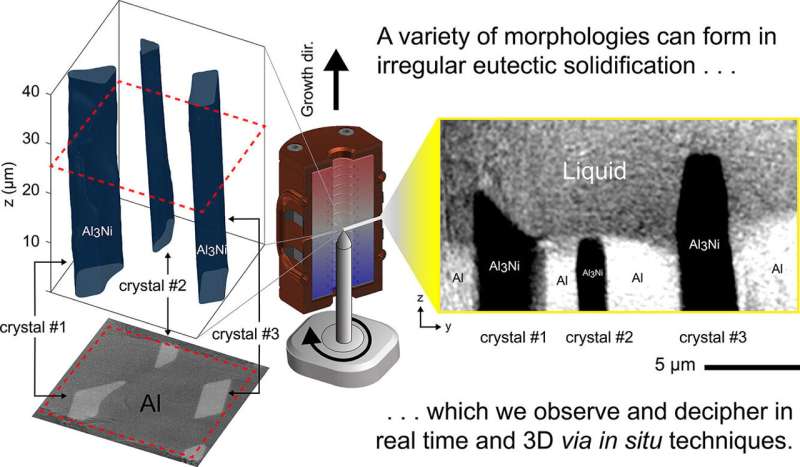This article has been reviewed according to Science X's editorial process and policies. Editors have highlighted the following attributes while ensuring the content's credibility:
fact-checked
peer-reviewed publication
trusted source
proofread
Unraveling the fundamental principles of eutectic solidification with real-time, nanoscale imaging

During eutectic solidification, a mixture of two or more solids self-assemble, forming composite microstructures ranging from ordered layers to intricate maze-like patterns that underlie properties like tensile strength or ductility.
Up to this point, researchers have not understood what conditions drive eutectics to form certain patterns, which is critical for designing reproducible next-generation eutectic composites.
Capturing real-time solidification of an aluminum-nickel eutectic alloy (Al-Al3Ni) in nanometer resolution revealed that increasing the solidification velocity shifts microstructure from irregular and faceted to regular and rounded, according to a study led by University of Michigan researchers recently published in Acta Materialia.
Leveraging this new understanding of eutectic formation will help tune microstructure for the material class used in high-temperature components in turbines or reactors.
"I have always been captivated by patterns in nature—like snowflakes, where no two are ever identical.
"This fascination with how such seemingly simple processes can give rise to endlessly rich, complex, and unique structures drives me to explore the underlying principles behind them," said Ashwin Shahani, an associate professor of materials science and engineering and chemical engineering at U-M and senior author of the study.
"In materials science, the same kind of wonder applies: how do small changes in conditions lead to dramatically different microstructures?"
To better understand how eutectic microstructures form, the research team designed a new in-situ furnace at the synchrotron beamline for directional solidification—a technique where the crystal growth from the liquid to solid phase is oriented in a specific direction. The apparatus permits precise control over the solidification processing space, enabling detailed study of pattern formation during eutectic solidification.
To correlate the nanoscale observations with microscale phenomena, the researchers combined two visualization techniques. Optical microscopy captured solidification over large space- and time-scales while synchrotron transmission X-ray microscopy provided nanoscale insights. The latter was conducted at the full-field X-ray imaging beamline 18-ID at Brookhaven National Laboratory's National Synchrotron Light Source II.
With this, they directly observed the interaction between the liquid, aluminum (Al) and nickel aluminide (Al3Ni) crystals during solidification under different conditions. The growth rate of Al3Ni compared to Al—called the degree of coupling—determined the shape of the solid microstructures left behind.
For example, when solidifying at lower velocities, the leading tips of the Al3Ni grow ahead of Al, causing irregular, faceted growth. At high solidification velocities, Al3Ni and Al grow at the same rate, resulting in rounded, regular growth.
In a casting, solidification velocity depends on several factors, including the thermal conductivity of the melt and the rate of heat extraction.
"Our first-of-its-kind experiments and real-time observations help to explain the great diversity of patterns produced by the solidification of eutectics containing stiff, intermetallic phases. These insights are essential to inform and validate simulations of materials synthesis," said Paul Chao, a doctoral graduate of materials science and engineering at U-M, who spent a full year in 2022 as a resident researcher embedded at the synchrotron beamline, and first author of the study.
"Our experiments serve as an example of how excellent mentorship at the University of Michigan, partnership with Brookhaven National Laboratory, and international collaboration are critical to cutting-edge research that can resolve fundamental scientific enigmas."
This finding is of broad relevance to a wide spectrum of eutectic systems including those that are metallic, semi-metallic and organic.
"Manipulating these patterns is more than just a technical pursuit—it is a way to unravel fundamental principles and apply them in meaningful ways, from improving the strength of materials to pioneering new approaches in materials design," said Shahani.
More information: Paul Chao et al, From irregular to regular eutectic growth in the Al-Al3Ni system: In situ observations during directional solidification, Acta Materialia (2024). DOI: 10.1016/j.actamat.2024.120314. On arXiv: DOI: 10.48550/arxiv.2408.14346
Journal information: arXiv , Acta Materialia
Provided by University of Michigan College of Engineering




















